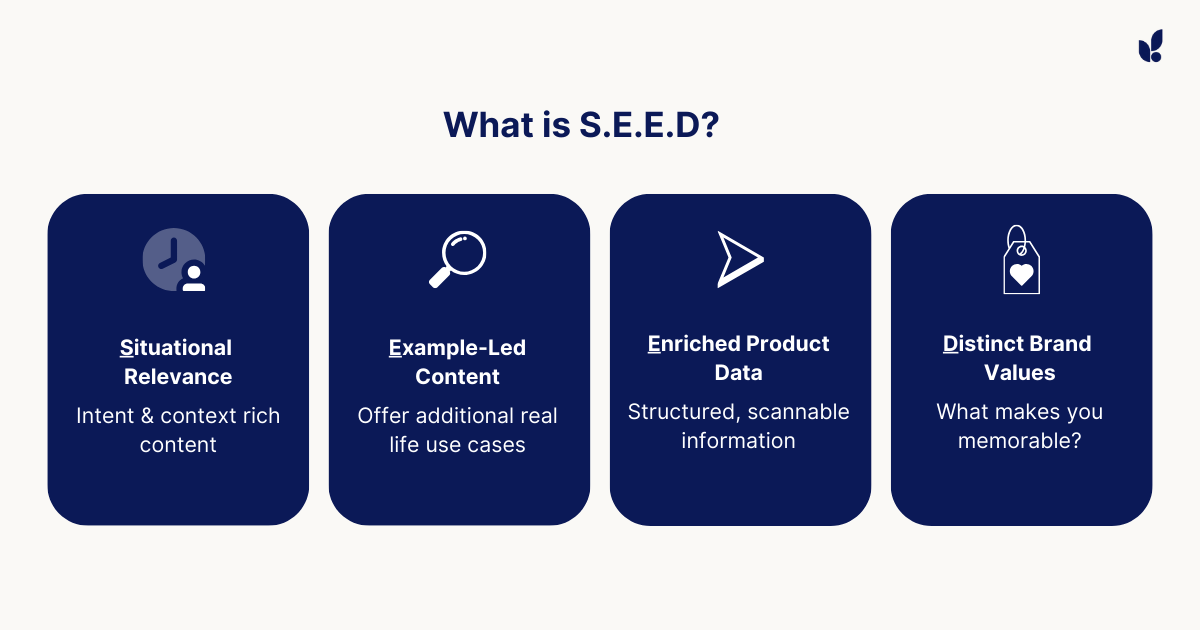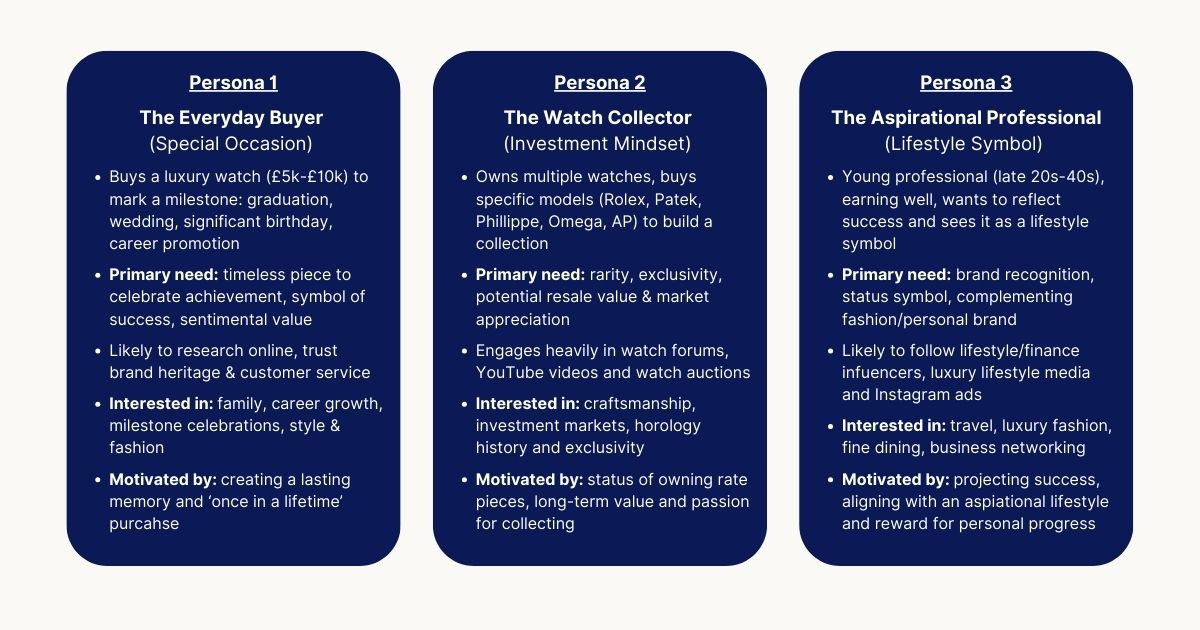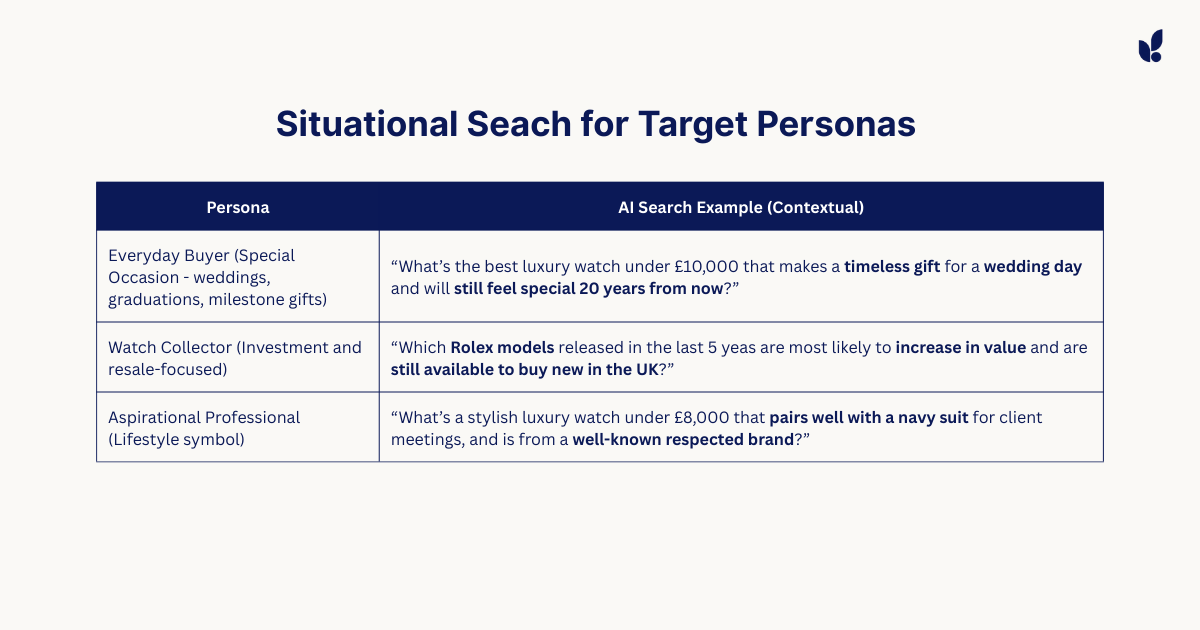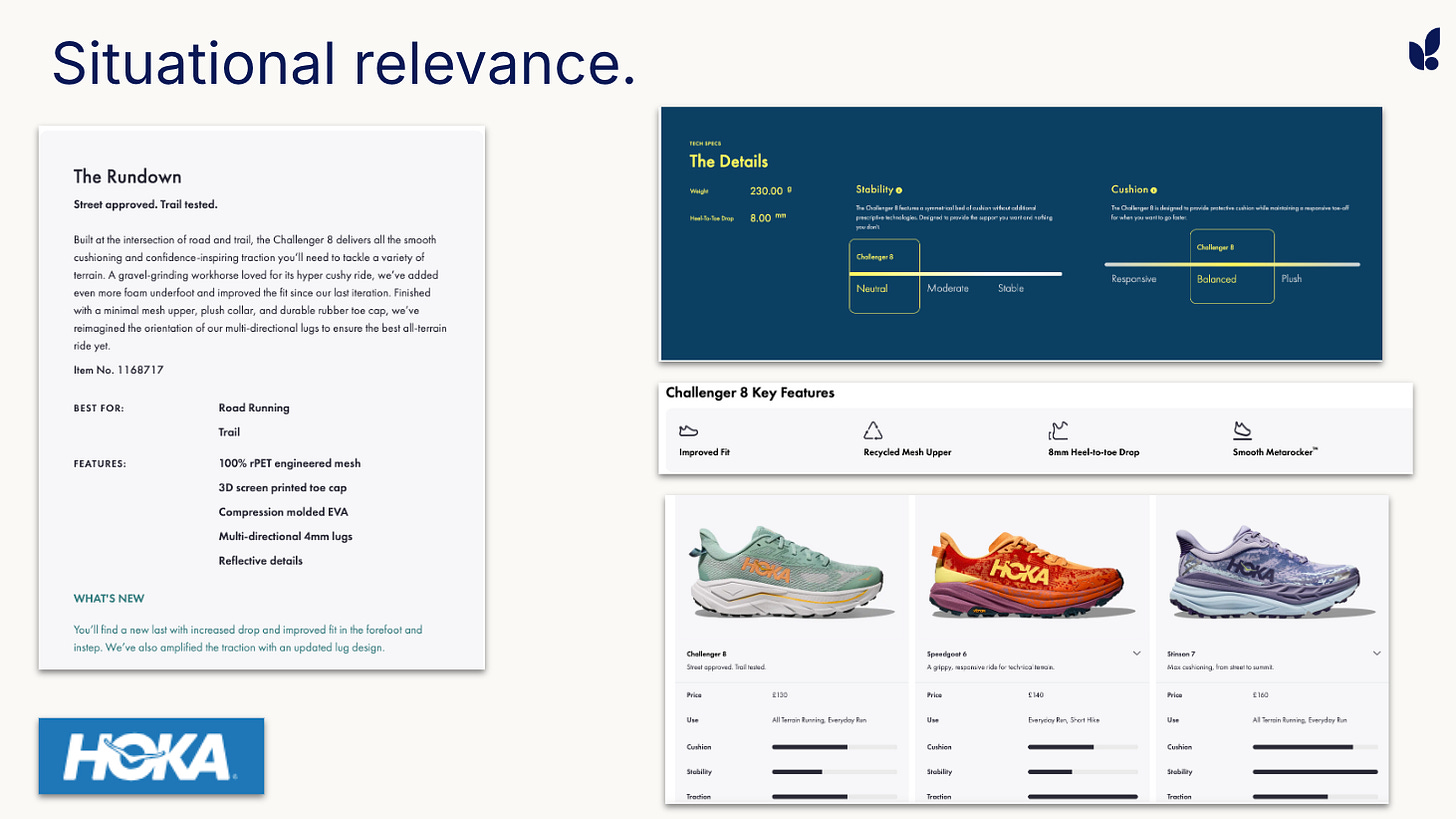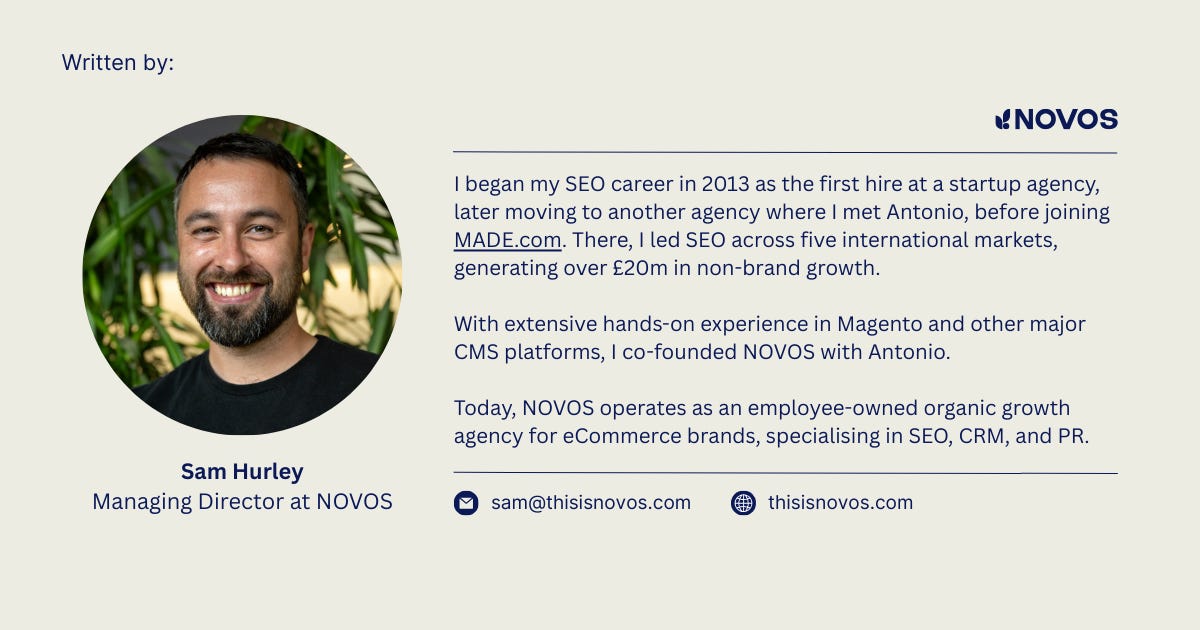Situational Search: How to get your brand discovered in LLMs
Situational Search: A fundamental change to how people search.
Last week, we introduced our SEED model as a framework for understanding how to adapt your eCommerce content for AI Search.
This week is part 1 of this 4-part series - today we’re talking about Situational Search.
Since ChatGPT’s introduction back in 2022, it’s taken nearly 2-3 years to start to impact search behaviour.
The 2 impacts can be summarised as:
‘Searches’ are getting longer, Google announced a 1.5x growth in searches for 5+ words
Searches are getting more specific, outlining 3-4 needs within a ‘search’
On top of this, the understanding of context and imagery is on a different level from what marketers have experienced in the past.
A potential customer can take a picture of their bookcase and ask, "What should I read next?" - marketers must adapt their content strategies to thrive in this expanding search landscape.
How does this impact you as a marketer?
You need to understand how ‘keywords’ are transforming.
Below is a comparison between traditional search terms and their evolution in AI Search, featuring examples from various industries.
The shift is driven by this new technology's ability to crawl, condense, understand, and deliver much more specific content based on customers' needs at precise moments.
This is how ChatGPT transformed search - elevating it to a new level that prompted Google to respond with its own AI mode.
Individuals’ needs are highlighted in bold. This visual shows searches now have 4-6 needs for this individual vs 1, maybe 2 for traditional search.
What are the key challenges marketers will face?
Less data-led, more data-informed.
Back in 2013, Google released Hummingbird, a fundamental change to how Google understands human language - for marketers, this brought the rise of how-to and information-led content.
AI mode + ‘Chat’ is another fundamental change to algorithms’ understanding of human intent and language.
SEO’s Keyword research tools have historically struggled to collect sufficient data for long-tail searches. This challenge will become even more pronounced in the AI Search era.
Marketers should focus on using keyword data to inform rather than lead search strategy.
This means using keyword data to understand broad demand for prioritisation, while placing greater emphasis on persona needs for content creation and search optimisation.
Resurgence of personas (not again!?)
Historically, for SEOs, when customer personas were defined, the keyword user journey between the personas wouldn’t change. So the activity became redundant or inefficient from an SEO perspective.
In this new AI search era, this persona mapping is going to become even more important.
Personas in AI Search
We can look at the Luxury Watch industry to provide us with a simple example of what this looks like.
For this example, we’re going to focus on three personas - each of their needs are outlined below.
In traditional search, their needs could be mapped with ‘long tail’ keywords under 3-4 words. As a result, their user journey was more or less identical because the depth wasn’t there.
Today, each of these personas would have very different needs they’d be searching for - see the example below.
Each of these personas has always had these needs, but the ability of search to provide seemingly unique and contextually relevant results wasn't possible until AI search. LLMs have a much deeper understanding of language and context compared to standard crawlers.
AI search is much more specific and situational, causing a greater divergence between search terms across different personas. This makes personas easier to identify based on search terms alone, as AI search queries contain detailed information about the user's specific needs. Your content, therefore, must address these needs directly.
So, as an eCommerce brand, how do you capitalise on this?
This requires both a fundamental mindset shift from eCommerce teams and a reprioritisation of efforts from SEO specialists.
eCommerce teams need to focus more on outlining who these products are created for throughout their commercial pages. This is largely focused on additional PLPs, but more importantly, the PDPs.
Addressing throughout the copy “who buys this product?” and more importantly, hinting towards “who doesn’t buy this product?” - it’s obvious to see why eCommerce brands have avoided this mindset in the past, at the potential detriment of conversion rate.
This new mindset needs to focus on marketing to the right personas through content for LLMs to surface, meaning a happier customer, longer LTV and no doubt stronger reviews, building longer-term brand authority in your niche.
An SEO’s mindset shift
From an SEO perspective, it puts more emphasis on the PDP pages. Historically, we’ve always prioritised the PLPs, and for good reason, the PLPs are what aim to rank for the high-volume competitive terms, so they need more love and attention.
However, with AI search, these LLM models want to be the PLP, and therefore, we’re putting more emphasis on the PDP pages.
Product detail pages (PDPs) are at the bottom of the funnel and highly commercial. With the new capabilities to understand, condense, and sort deep content, we're likely to see greater success by focusing on PDPs.
This doesn't mean PLPs should be ignored - they're still valuable for targeting persona needs of repeat customers and for demonstrating your authority and product range in these areas.
HOKA is one of the best examples we’ve seen of this in action
The PDPs are littered with situational content like:
Best for
Key features
Comparison of their own PDPs vs PDPs
Scale of key features their personas are no doubt focused on: stability + comfort
The screenshot above, at a glance, helps you to understand key differences between their products and why certain products differ from each other.
How does off-site SEO play into Situational Search for LLMs?
External coverage still acts as extra validation on internal claims.
External reputation and authority are still harder to build, hence why so many eCommerce brands focus on ads - it’s short-term and quick, but ads don’t build brand trust.
In AI search, this is called citation building as it focuses on the following, as illustrated by the visual below:
Getting cited in LLMs sources (example below, getting coverage on Esquire for luxury trainers)
Being an authority in the niche to provide content onsite that LLMs cite as the source (example below, your brand is an authority for luxury trainers, therefore writing content around it could mean you become a source next to Esquire within answers)
Both, using the example image below. You are both a cited source (onsite SEO) as well as being cited within the other sources (offsite SEO)
Digital PR tactics that can help with Situational Search:
UGC from existing personas helps to reinforce that your product and brand satisfy their needs - this can also be used onsite on PDP pages.
Validator of authority: External coverage acts as extra validation on internal claims. Google always viewed a backlink as a ‘vote’ or an ‘endorsement’; this way of thinking is still the same today, just now mentions are just as valuable.
Relevance: Niche-relevant publications your personas read can raise awareness of your product, change the perception of your brand as well as improve citations in LLMs.
Additional signals of credibility + depth can help with awards, research, or being the “go-to” source journalists use.
Trend-jacking: Situational search also has a time-bound element. PR-driven campaigns around seasonal, cultural, or trend-based moments help LLMs connect your brand to timely situations rather than static ones. For emerging trends that become evergreen over time, establishing your brand as one of the first associated with the trend helps build long-term authority.
Expert validation: this starts to go into the next post in the series around Expert + Experience, but getting these quotes from founders/designers in authority outlets helps build the credibility and trust of the brand
Search is evolving and expanding, but broadly speaking, the strategies that worked for traditional SEO still work for AI search. The difference lies in the weighting and prioritisation applied at a tactical level to adapt to this new technology and its impact on how people search for products and brands.
Situational search represents a fundamental shift in how this technology better understands human intent and language, resulting in more relevant results for deeper, more contextual needs. We believe this places greater emphasis on brand personas and demonstrates how SEO teams must work more closely with brand teams to unearth product and brand USPs. This collaboration enables LLMs to better understand and surface your products or brand for potential customers.
Part 2 of this series will focus on Expert-experience led content, a key priority Google has introduced that brands can leverage to distinguish themselves and stand out from the ever-rising generic AI-generated content.




